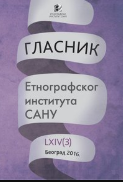The Folk Tradition and its Transformation in the Context of Social Influences and Contributions by Individuals (Using the Slovácko ‘Verbuňk’ Male Recruitment Dance as an Example)
The Folk Tradition and its Transformation in the Context of Social Influences and Contributions by Individuals (Using the Slovácko ‘Verbuňk’ Male Recruitment Dance as an Example)
Author(s): Martina PavlicováSubject(s): Theatre, Dance, Performing Arts, Museology & Heritage Studies, Customs / Folklore, Recent History (1900 till today), Cultural Anthropology / Ethnology
Published by: Етнографски институт САНУ
Keywords: tradition; folklore; dance; Verbuňk; folk revival;
Summary/Abstract: 2005 saw the approval of the Czech Republic’s nomination of the Slovácko ‘Verbuňk’ dance for inclusion in UNESCO’s Representative List of the Intangible Cultural Heritage of Humanity. It may be characterized as an improvisational male dance, improvised individually, which contains jumping figures. It may be interpreted by a large number of dancers simultaneously, but may also be a solo dance. Geographically, it comes from the Slovácko ethnographic region in south-eastern Moravia. In the second half of the 20th century, it was known particularly among folklore ensembles and at natural events, and its performance was significantly tied to the folk revival movement. Although the name of the dance—the Verbuňk—suggests a relationship with forced army recruitment in the 18th century (verbování comes from the German term for recruitment: Werbung), the significant period for the development of the dance extends even further back. The dance strongly reflected intellectual interests in folk culture in the late 19th and early 20th centuries and the folk revival movement that was based upon it. Key figures in both amateur and professional dancing had a major influence on the dance’s development. (It started as a male dance characterized by rhythmical movement of the legs, the so-called cifrování or ‘decoration’ of the dance, developing into a strong individual dance with a vocal prelude, dance figures and accelerating tempo.)
Journal: Гласник Етнографског института САНУ
- Issue Year: LXV/2017
- Issue No: 2
- Page Range: 305-320
- Page Count: 16
- Language: English

